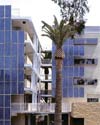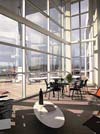The American Institute of Architects (AIA) Committee on the Environment (COTE) selected this year’s Top 10 Green Building Projects as examples of architectural and green design solutions that protect and enhance the environment. The projects make a positive contribution to their community, improve comfort for building occupants and reduce environmental impacts through strategies such as: reuse of existing structures, connection to transit systems, low-impact site development, energy and water conservation, use of green construction materials, and design that improves indoor air quality.
Chicago Center for Green Technology 
Through collaboration between a variety of public and private entities, a blighted and unsafe industrial site has become an example of how one project can help rebuild a community. This center does just that by instigating an overhaul for a part of Chicago that has seen neglect and disinvestment for decades. The building now houses a high-tech factory, educates the public on sustainability, and is home to a community gardening training facility helping people find good jobs in the industry.
This project is an ambitious LEED Platinum design that uses almost 50 percent less energy than comparable construction, gets over 17 percent of its energy from photovoltaic cells and used over 36 percent recycled materials in its construction. Additionally, the building manages all storm water on-site including collecting rainwater for irrigation. The architects strived to use every design feature and technology in multiple ways. PV panels are also sunshades. A public bench is also a major heating duct. Farr Associates Architecture
and Urban Design.
Colorado Court, Santa Monica, CA.
The 44-unit five-story building is the first affordable housing project in the U.S. to be 100 percent energy neutral. This project is a model of sustainable development in an urban environment and promotes diversity through strategically placed affordable housing.
Innovative sustainable-energy technologies include a natural gas-powered turbine/heat recovery system that generates the base electrical load and services the buildings hot water needs. A solar electric panel system integrated into the facade and roof supplies most of the peak-load energy demand. This unique co-generation system converts utility natural gas to electricity for the buildings power needs. This system also captures and uses waste heat to produce hot water and space heating for the residents. The unused energy from these passive solar panels is returned to the grid during daytime hours. Annual savings in electricity and natural gas exceed $6,000. The building also collects rainwater runoff from the entire city block and funnels it into a series of underground chambers.
Herman Miller Marketplace, Grand Rapids, MI.
The expectation of this office space began as the creation of a great place to work, but the resulting Marketplace is among the nations first design/build Gold LEED certified buildings. Additionally, the buildings documented operational costs are becoming a national benchmark for sustainable and energy efficient design solutions. The design team worked to create an efficient building filled with natural light, fresh air and space, carefully crafted for maximum human comfort, without losing track of cost issues. Project goals include increasing the efficiency of the heating and cooling systems, minimizing lighting system energy demands and using sustainable materials. The goal of the project – to develop an environmentally sensitive, economically viable office project began before soil was moved with the development of a site sediment and erosion control plan that conforms to the Environmental Protection Agency standard.
The sixth annual AIA/COTE Top Ten Green Projects initiative was developed in partnership with the U.S. Department of Energy and Environmental Building News. The panel of jurors included: Peter Bohlin, FAIA, of Bohlin Cywinski Jackson; Carol Ross Barney, FAIA, of Ross Barney + Jankowsky; Drury Crawley, AIA, U.S. Department of Energy; Jacqueline Rose, AIA, Environmental Protection Agency; and Douglas Kelbaugh, FAIA, University of Michigan.
++++
See the other winners.
Excerpted from Environmental Design + Construction, a SustainableBusiness.com Content Partner
AIA's Top Ten Green Projects 2003

Published on: September 22, 2003
(Visited 39 times, 2 visits today)